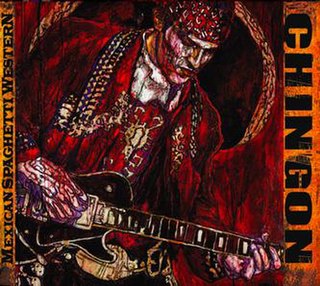José L. Hernández is a Mexican mariachi musician.

Son huasteco is one of eight Mexican song styles and is a traditional Mexican musical style originating in the six state area of Northeastern Mexico called La Huasteca. It dates back to the end of the 19th century and is influenced by Spanish and indigenous cultures. Usually it is played by a Trio Huasteco composed of a guitarra quinta huapanguera a Jarana huasteca and a violin. Singers will often use the falsetto register. The son huasteco is particularly noteworthy for its flamboyant and virtuoso violin parts, although the style varies from state to state. Footwork often danced to son huasteco is the Zapateado. Improvisation plays a strong role in the style, with musicians creating their own lyrics and arrangements to a standard repertoire. Typical sones huastecos are "Cielito Lindo", "La huazanga", "La sirena", "El querreque" and "La cigarra".

Three on the Trail is the debut studio album by the Western band Riders in the Sky, released in 1979 by Rounder Records Group.

Federico Arturo Guízar Tolentino, known professionally as Tito Guízar, was a Mexican singer and actor. Along with Dolores del Río, Ramón Novarro and Lupe Vélez, as well as José Mojica, Guízar was among the few Mexicans who made history in the early years of Hollywood.
"Limerick" is a traditional humorous drinking song with many obscene verses. The tune usually used for sung limericks is traditionally "Cielito Lindo," with the words arranged in the form of a limerick.

Mexican Spaghetti Western is a studio album by Robert Rodriguez's band, Chingon. Originally released in 2004 exclusively on the band's website, it became available in stores on April 10, 2007. The original non-digi-pak release of the album did not include the song "Cielito Lindo".

"Cielito Lindo" is a Mexican folk song or copla popularized in 1882 by Mexican author Quirino Mendoza y Cortés. It is roughly translated as "Lovely Sweet One". Although the word cielo means "sky" or "heaven", it is also a term of endearment comparable to "sweetheart" or "honey". Cielito, the diminutive, can be translated as "sweetie"; lindo means "cute", "lovely" or "pretty". The song is commonly known by words from the refrain, "Canta y no llores", or simply as the "Ay, Ay, Ay, Ay song".

Are You Ready for Freddy? is an album by Freddy Fender. It was released in 1975 on Dot Records and is a collaboration between the singer and producer Huey P. Meaux.
Malagueña Salerosa — also known as La Malagueña — is a well-known Son Huasteco or Huapango song from Mexico, which has been covered more than 200 times by recording artists.

The Bandit is an album by The Nashville String Band. The band consisted of Chet Atkins and Homer and Jethro.

Alejandro Alcondez Is a Mexican/American Actor, Filmmaker, Film Director, Film Producer and Screenwriter. Born in Jalisco, Mexico, Alcondez moved to Hollywood, California in the early 1990s. His acting career began in theater production plays, he then moved on to produce and write his own Mexican films Impacto de Muerte, Furia Salvaje and El Bronko Negro, which were distributed by his company Producciones Alejandro Alcondez.
"México lindo y querido" is a traditional mariachi and ranchera Mexican song written by Chucho Monge and made famous by singer Jorge Negrete. He sang it in the 1952 movie Forever Yours.

Oy is the third studio album by the Iranian singer-songwriter Mohsen Namjoo after Toranj and Jabr-e Joghrafiyaei. Released on 6 October 2009 this was Namjoo's first album produced and published outside Iran.

Dos guitarras flamencas en América Latina is the second of four collaboration albums by Paco de Lucía and Ramón de Algeciras.
"Cielito Lindo" is a Spanish Mexican song written by Quirino Mendoza y Cortés.

Cielito Lindo is a 2010 drama–thriller film produced, written and directed by Alejandro Alcondez. He wrote it especially for himself where he himself plays the starring role of Pablo Pastor in the film. It was released by his production and distribution company Alejandro Alcondez Pictures.

Out of the Storm is the debut album led by American drummer Ed Thigpen recorded in 1966 for the Verve label.

Quirino Mendoza y Cortés was a Mexican composer of the famous traditional songs "Cielito Lindo" and "Jesusita en Chihuahua". He was born in Santiago Tulyehualco, Xochimilco, Mexico City in 1862.

Cielito Querido Café is a Mexican coffee shop chain inspired by Latin American history that sells typical Mexican beverages and foods. Brenda Montero is the current CEO of the company. The brand vends typical Mexican products including chamoyadas, hot horchata, café de olla, ponche, and sweet bread.
"Cielito Lindo" is a traditional and popular Mexican song with the refrain "Ay ay ay ay".












